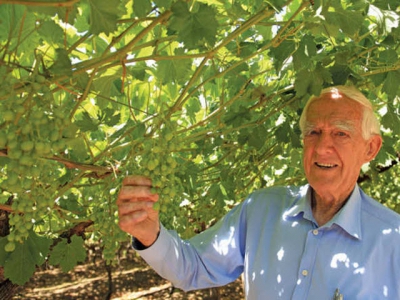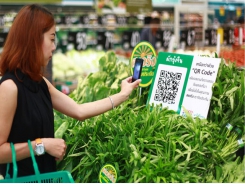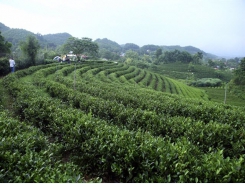Secrets of a visionary fruit farmer

Western Cape fruit farmer Aat Hoekstra (85) recently received the South African fruit industry’s OSH Reinecke Industry Leader Award for 2015. The British Journal of Fresh Produce has also referred to him as South Africa’s fruit-breeding pioneer. He shared his wisdom with Glenneis Kriel.
Aat Hoekstra owns Hoekstra Fruit Farms, which employs 300 permanent and 1 600 seasonal workers. Photo: Glenneis Kriel
To be a successful farmer, get the basics right. Work hard, produce the right product for the right market, foster good relations with your workers, and have access to relevant information.
This is according to Aat Hoekstra, recipient of the South African fruit industry’s prestigious OSH Reinecke Industry Leader Award for 2015.
Aat started as a farm labourer in 1950 and worked his way up to ownership of Hoekstra Fruit Farms. Today, the company produces table grapes and melons on 12 production blocks around Paarl in the Western Cape, and employs 300 permanent and up to 1 600 seasonal workers in peak season.
Workers are divided into small teams, each with a supervisor to ensure quality work. Goals are set and targets must be reached.
Humble beginnings
Aat grew up on a smallholding in Westland in the Netherlands, where his father cultivated flowers and table grapes in glasshouses.
This exposure gave Aat an abiding interest in farming from a young age. In 1950, he came to South Africa on holiday, fell in love with the country and decided to stay.
“I was enchanted by the people, the vast spaces and mountains – it was a country full of possibilities. I decided to make my future here,” he recalls. He started working on a farm in Paarl.
“I worked hard and found favour with the owner, Jan Kirsten. He encouraged me to import bulbs from Holland and allowed me to cultivate them on a part of his land. The flowers, which required artificial heating in the Netherlands, thrived under the African sun and after four years, with his help I bought Nancy, my first farm. It was 12ha.”
Exporting melons
Although Nancy had a small block of table grapes, Aat focused mainly on cut flowers, which generated a more constant income. In the 1970s, he replaced the flowers with green-flesh melons, and started exporting these to Europe and the UK under his own name.
As one of the first farmers in South Africa to export melons, he played a major role in developing an export protocol for them.
Melons became the main source of income on the farm until air freight became so expensive that export no longer made economic sense.
So he downscaled and sold most of the fruit on the Johannesburg and Pretoria fresh produce markets. Table grapes are now the main focus of his production.
Grape production
Aat started by producing 3 000 wooden boxes of table grapes a year, each the weight of a modern 4,5kg carton. Today, the farm produces more than 1,2 million cartons of table grapes a year on 300ha, adding value by cooling the fruit at Noord Agter-Paarl Koelkamers and marketing it through Hoekstra Fruit Exporters.
Both are subsidiaries of Hoekstra Fruit Farms. The company has also played an important role in supplying new table grape varieties to growers in South Africa.
One of the most valuable lessons Aat learnt was to aim at a single goal.
“Focus on what you want to achieve and not on too many things at a time. Don’t become so diversified that it negatively affects production,” he advises.
The need to stay ahead
When Aat started taking table grape production seriously, he became aware of the shortage of good cultivars in South Africa.
Back then, the Berg River area produced only three cultivars, and the Hex River Valley four. He set out to learn more about production and scouted for new cultivars and varieties in Israel, Egypt, Romania, Turkey, Italy and Spain.
He learnt valuable production lessons from growers in these countries and acquired planting and distribution rights for the cultivars Prime (from Israel) and Victoria (from Romania).
Since then, South Africa, with support from government, has become the largest fruit- exporting country in the southern hemisphere.
But Aat is concerned that in recent years agricultural research has not received the support that it deserves. “To remain a global competitor, we must stay on top of our game. We cannot afford to stagnate,” he warns.
New cultivars, new markets
When Aat imported the Prime and Victoria cuttings in 1993, they had to stay in quarantine for almost a year. They were then inoculated onto rootstocks on the farm where Aat started proliferating them. “The cultivars thrived under our production conditions,” he recalls.
Today, SA producers export about a million cartons of Victoria and six million cartons of Prime grapes. These produce more fruit per hectare than traditional cultivars while requiring less labour.
To this day, Prime is the earliest table grape variety in the country, in addition to being seedless.
Aat nevertheless farms with several seeded varieties, having found a good niche for seeded grapes in certain markets. Hoekstra Fruit Farms currently grows four cultivars, of which three are seeded varieties and have not yet been released to the market. Its seeded Muscat Delight achieves a premium price.
“Perhaps this market is sentimental but it tends to believe that seeded grapes taste better and have more flavour than seedless grapes,” he explains. “It may also associate this with more health benefits.
Even so, farmers should be aware of the general trend towards seedless grapes. SA vineyards have gone from only seeded varieties to more than 75% of land under seedless varieties today.”
Aat is fortunate to have had so much success with Prime and Victoria cultivars. “We’ve imported hundreds of varieties and cultivars since then. Most didn’t perform as well under production conditions here as in their countries of origin.”
He advises farmers to keep a finger on the pulse of the market’s demands and stay up to date with new varieties.
“It makes sense to continually test new cultivars to see how they perform under our production environment. Planting a new vineyard is too expensive a process to gamble with something you don’t really know,” he says.
Caring for employees
The right cultivar and a ready market are crucial, says Aat, but equally important is the support of one’s workers.
“A farmer cannot do everything by himself,” he explains.
“This applies even more to farming today than it did in the past. “A farmer cannot afford to plant the right cultivars if the workers go on strike during peak season.
“Equally, a farmer should consult experts when needed – he cannot know everything.”Aat’s workers benefit directly from the farm’s success. Their pay is significantly higher than the minimum wage, and profit-sharing – introduced five years ago – gives the lowest-paid workers between 12% and 15% of their annual wage, and this is on top of an annual bonus.
Workers with more responsibility get a slightly higher percentage, as do those with a better absenteeism record.
“This has positively influenced worker-performance. Workers are more accountable and take responsibility for their tasks as they realise that their actions have a direct affect on farm profitability,” explains Aat.
The Farm Worker of the Year competition has also had a positive impact, and employees are encouraged to participate. Hoekstra Fruit Farms has had several category winners, and two years ago Hoekstra employee Abie Edon was the overall winner of the Berg River Valley region.
He has since been promoted to farm manager on a unit. “The competition has sparked healthy competition among our workers. It encourages people to excel at their jobs,” says Aat.
Decision-making and responsibility
Training is regarded as important for efficiency. Workers are also encouraged to take part in decision-making and to take ownership of their work. Managers meet on Saturdays to identify priorities, and decide on actions required.
These are communicated to assistant managers who pass the information on to the workers.
“Allowing workers to take part in decision-making helps us to come up with ideas and solutions that I might not have thought of if I had to run the farm on my own,” explains Aat. “Developing their own solutions to problems also means that they actively take part in implementing those solutions.”
This approach is also used to help employees take responsibility for themselves and their families. A Future Forum consisting of workers represents each farm and helps employees tackle these issues. The company offers scholarships to the children of permanent employees who want to study after completing school.
“You can’t force people to study something they’re not interested in, so we offer scholarships for any tertiary qualification even if it has nothing to do with agriculture. “But there are conditions. The children have to achieve certain marks for matric and finish the course,” he stresses.
Various Farming models
Farming units are based on the Moshav farming model from Israel. Under this, each farmer owns his own property and is responsible for his own profit, but labour and other resources are pooled to enhance profitability. It is different from the Kibbutz model, where all resources, including land and earnings, are shared.
“A farm manager is responsible for the profitability of each farming unit at Hoekstra Fruit Farms,” Aat explains. “Marketing, packing, administration and labour are done from a central point. People also help each other in a crisis.
There is a sense of camaraderie, with people looking out for one another. “The Moshav system could also help farmers who are too small to make it on their own. With farms becoming larger, farmers who cannot expand production could remain sustainable through pooling resources.”
The need for humility
A farmer should remember his dependence on external factors such as favours from others and nature, stresses Aat.
“I’ve been very fortunate all my life. It seems as if things always worked out for the best, something I’m very grateful for.”
But all farmers, despite new technology, are ultimately as dependent on nature as they were in the past, he points out.
Related news
Tools

Phối trộn thức ăn chăn nuôi

Pha dung dịch thủy canh

Định mức cho tôm ăn

Phối trộn phân bón NPK

Xác định tỷ lệ tôm sống

Chuyển đổi đơn vị phân bón

Xác định công suất sục khí

Chuyển đổi đơn vị tôm

Tính diện tích nhà kính

Tính thể tích ao




 Agriculture in a position to grow
Agriculture in a position to grow  Bac Giang farmers cash in on citrus fruit…
Bac Giang farmers cash in on citrus fruit…